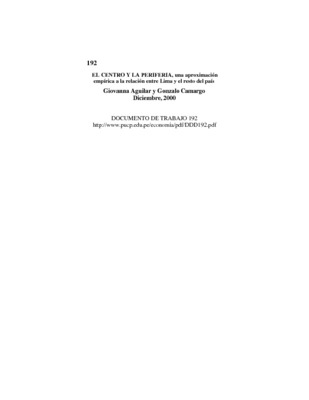| dc.contributor.author | Aguilar, Giovanna | |
| dc.contributor.author | Camargo, Gonzalo | |
| dc.date.accessioned | 2015-03-19T20:37:41Z | |
| dc.date.available | 2015-03-19T20:37:41Z | |
| dc.date.issued | 2000 | |
| dc.identifier.uri | http://repositorio.pucp.edu.pe/index/handle/123456789/46832 | |
| dc.description.abstract | El objetivo de este trabajo es evaluar empíricamente el efecto de los shocks que afectan el crecimiento de Lima sobre las tasas de crecimiento del resto de departamentos. No pretendemos describir los mecanismos de transmisión a través de los cuales el crecimiento de Lima afecta el crecimiento del resto del país, sino más bien identificar los efectos negativos y positivos de los shocks que se originan en Lima, considerada el centro, sobre el resto de departamentos, conside-rados la periferia. Se empleará un modelo de Vectores Autorregresivos en su representación de medias móviles (VMA), en el cual las variables endógenas son la tasa de crecimiento de Lima, la tasa de crecimiento y la tasa inflación de un departamento de la periferia. Se supone que estas variables son afectadas por shocks de oferta y demanda originados en el centro y la periferia. Para ortogonalizar la matriz de varianza-covarianza de los errores estimados se utilizará la descompo-sición de Blanchard & Quah, la cual supone que las innovaciones o shocks de demanda agregada no tienen un efecto en el largo plazo sobre el producto. | es_ES |
| dc.description.abstract | The main purpose of this paper is to evaluate empirically the economic relation between Lima and some departments of the country by estimating the effect of shocks affecting Lima’s growth over the rates of growth of the remaining departments. We do not pretend to describe the mechanisms of transmission but to identificate the negative and positive effects of shocks coming from Lima, considered “the center,” over the rest of departments, considered “the periphery”. It will be used the Autorregresive Vector Model in its Moving Average representation (VMA), in which the endogenous variables are Lima’s rate of growth, the rate of growth and the rate of inflation of a periphery department. It is assumed that these variables are affected by shocks of demand and supply originated in the center and the periphery. In order to ortogonalize the estimated error variance-covariance matrix we will use the Blanchard and Quah decomposition, in which innovations or aggregate demand shocks have no effect over the product on the long run. | en_US |
| dc.language.iso | spa | es_ES |
| dc.publisher | Pontificia Universidad Católica del Perú. Departamento de Economía | es_ES |
| dc.relation.ispartofseries | Documento de Trabajo;192 | es_ES |
| dc.rights | info:eu-repo/semantics/openAccess | es_ES |
| dc.rights.uri | http://creativecommons.org/licenses/by-nc-nd/2.5/pe/ | * |
| dc.subject | Ajuste estructural--política económica--Perú | es_ES |
| dc.title | El centro y la periferia: una aproximación empírica a la relación entre Lima y el resto del país | es_ES |
| dc.title.alternative | Center and periphery: An empirical approach to the relationship between Lima and the rest of the nation. | en_US |
| dc.type | info:eu-repo/semantics/workingPaper | |
| dc.type.other | Documento de trabajo | |
| dc.subject.ocde | http://purl.org/pe-repo/ocde/ford#5.02.00 | |
| dc.publisher.country | PE | |
| renati.advisor.orcid | https://orcid.org/0000-0003-2031-5328 | |


